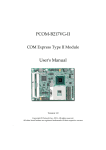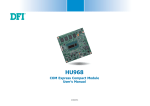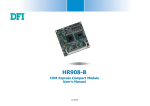Download ET850 USER'S MANUAL
Transcript
ET850 AMD Athlon™ II / Turion™ II Neo CPU 785E + SB820M COM Express (Type II) CPU Module USER’S MANUAL Version 1.0A Acknowledgments PS/2 is a trademark of International Business Machines Corporation. AMD and Athlon™ II Neo are registered trademarks of Advanced Micro Devices, Inc. Microsoft Windows is a registered trademark of Microsoft Corporation. All other product names or trademarks are properties of their respective owners. ii ET850 User’s Manual Table of Contents Table of Contents............................................................. iii Introduction ....................................................... 1 Product Description ............................................................................... 1 Checklist ................................................................................................ 2 ET850 Specifications............................................................................. 3 Dimensions ............................................................................................ 4 Installing the Memory ........................................................................... 5 Jumpers and Connectors on ET850 ....................................................... 6 JB1: Clear CMOS Setting ............................................................. 6 J2, J3: COM Express Type 2 Connectors ..................................... 6 COM Express Type 2 Connectors ................................................ 7 BIOS Setup ......................................................... 9 Drivers Installation ...................................... 29 VGA Drivers Installation .................................................................... 30 Audio Drivers Installation ................................................................... 35 LAN Drivers Installation ..................................................................... 36 Marvell LAN Drivers Installation (IP401-B1 carrier board only)....... 38 ET850 User’s Manual iii The ET850 COM Express CPU Module iv ET850 User’s Manual INTRODUCTION Introduction Product Description The ET850 COM Express Module comes on board with the AMD Athlon II Neo or AMD TurioT II Neo processors and powered by the AMD 785E + SB820M chipset. The chipset has built-in Radeon HD4200 graphics engine with enhanced operating modes to enable excellent graphics performance in power and embedded applications. The DirectX® 10.1 feature lets you enjoy awesome graphics performance, stunning 3D visual effects and dynamic Interactivity. The board has one DDR3-800 SO-DIMM socket supporting up to 4GB of system memory. ET850 supports high speed connectivity with two SATA III, four serial ports, eight USB and a Gigabit LAN controller. Dimensions of the CPU module are 95mm x 125mm. ET850 Features y AMD Athlon™ II Neo / Turion™ II Neo Processors onboard, up to 2.2GHz y 1x DDR3-800/1333 SO-DIMM, Max. 4GB y Integrated VGA, supports CRT & LVDS y Watchdog timer, HD Audio y 2x SATA II, 1x GbE, 8x USB 2.0, 4x COM via baseboard ET850 User’s Manual 1 INTRODUCTION Checklist Your ET850 package should include the items listed below. • The ET850 CPU Module • Heat spreader for ET850 • This User’s Manual • 1 CD containing the following: • Chipset Drivers • Flash Memory Utility Remarks: After installing the heat spreader (provided with the CPU module), please install an additional heat spreader for better heat dissipation. 2 ET850 User’s Manual INTRODUCTION ET850 Specifications Product Name Form Factor CPU Type CPU Operate Frequency Cache CPU Socket Chipset BIOS Memory VGA LVDS LAN USB Serial ATA Ports Parallel IDE Audio RTC Watch-Dog Timer Connector to Carrier Board Power Other RoHS Board Size ET850 COM Express CPU module TM TM AMD Geneva ASB2 Turion II Neo / Athlon II Neo DC CPU Dual-Core CPU (27 x 27 mm) /45nm SOI / ECC capable FSB up to 3200 MHz Hyper Transport TM AMD Athlon II Neo N36L=1.3GHz DC (12W) [ET850-13] TM AMD Turion II Neo N54L=2.2GHz DC (25W) [ET850-22] TM AMD Turion II Neo N54H=2.2GHz DC (25W) [ET850-22H] 2MB 812-ball BGA ASB2 CPU on board AMD 785E NB : 21 mm x 21 mm AMD SB820M SB: 21mm x 21mm AMI BIOS DDRIII-800 SO-DIMM x1 , Max. 4GB (Non-ECC) ** Please note N54H can support to 1333MHz** AMD 785E built-in ATi HD4200 Graphics Core CRT w/ DF13 connector (via internal RAM DAC) AMD 785E built-in 1 x 24-bit dual channels w/ DF13 socket x2 (via LVTM) Realtek 8111DL PCI-Express GbE x 1 SB820M built-in USB 2.0 host controller, supports 8 ports SB820M built-in controller, supports 2 ports for SATA 3.0 (6 Gb/s) JMicron JM368 (PCI-e to PATA) x1 for 1 PATA channel for IDE SB820M Built-in Audio controller + HD Codec ALC662 w/ 6 channels (Line-out, Line-in, Mic.) SB820M built-in RTC with on board battery Yes (256 segments, 0, 1, 2…255. sec/min) Two 220-pin connectors (A-B & C-D) [COM Express 2.0 standard] +5V, +3.3V, +12V ,+5VSB LAN Wakeup Yes 95mm x 125mm ET850 User’s Manual 3 INTRODUCTION Dimensions Remarks: After installing the heat spreader (provided with the CPU module), please install an additional heat spreader for better heat dissipation. 4 ET850 User’s Manual INTRODUCTION Installing the Memory The ET850 COM Express CPU module accommodates 240-pin DDR3 SODIMM memory modules with capacities up to 4GB. Non-ECC is supported. Installing and Removing Memory Modules To install the DDR3 modules, locate the memory slot on the board and perform the following steps: 1. Hold the DDR3 module so that the key of the DDR3 module align with those on the memory slot. Insert the module into the socket at a slight angle (approximately 30 degrees). Note that the socket and module are both keyed, which means that the module can be installed only in one direction. 2. To seat the memory module into the socket, apply firm and even pressure to each end of the module until you feel it slip down into the socket. 3. With the module properly seated in the socket, rotate the module downward. Continue pressing downward until the clips at each end lock into position. 4. To remove the DDR3 module, press the clips with both hands. ET850 User’s Manual 5 INTRODUCTION Jumpers and Connectors on ET850 JB1: Clear CMOS Setting JB1 Setting Normal Clear CMOS Note: With jumper pin 1-2 short, it automatically saves the last BIOS settings when battery is removed, but it is not case with jumper pin 2-3 short. J2, J3: COM Express Type 2 Connectors The Type 2 connectors come in two 220-pin 0.5mm pitch receptacles. They include PCI, IDE, GBE and up to 22 general-purpose PCIE lanes (PCIE 0-5 and PCIE 16-31). For most Type 2 implementations, it is expected that PCIE lanes 16-31 are used for graphics. Hence they are designated PEG lanes 0-15 in the following table. Modules implementing Pin out Type 2, such as the ET850, uses the pin-out shown. 6 ET850 User’s Manual INTRODUCTION COM Express Type 2 Connectors Pin A1 A2 A3 A4 A5 A6 A7 A8 A9 A10 A11 A12 A13 A14 A15 A16 A17 A18 A19 A20 A21 A22 A23 A24 A25 A26 A27 A28 A29 A30 A31 A32 A33 A34 A35 A36 A37 A38 A39 A40 A41 A42 A43 A44 A45 A46 A47 A48 A49 A50 Row A Signal GND (FIXED) GBE0_MDI3GBE0_MDI3+ GBE0_LINK100# GBE0_LINK1000 # GBE0_MDI2GBE0_MDI2+ GBE0_LINK# GBE0_MDI1GBE0_MDI1+ GND (FIXED) GBE0_MDI0GBE0_MDI0+ GBE0_CTREF SUS_S3# SATA0_TX+ SATA0_TXNC SATA0_RX+ SATA0_RXGND (FIXED) NC NC SUS_S5# NC NC BATLOW# SATA_ACT# HDA_SYNC HDA_RST# GND (FIXED) HDA_BITCLK HDA_SDOUT BIOS_DIS0# THRMTRIP# USB6USB6+ USB_6_7_OC# USB4USB4+ GND (FIXED) USB2USB2+ USB_2_3_OC# USB0USB0+ VCC_RTC EXCD0_PERST# EXCD0CPPE# LPC_SERIRQ Pin B1 B2 B3 B4 B5 B6 B7 B8 B9 B10 B11 B12 B13 B14 B15 B16 B17 B18 B19 B20 B21 B22 B23 B24 B25 B26 B27 B28 B29 B30 B31 B32 B33 B34 B35 B36 B37 B38 B39 B40 B41 B42 B43 B44 B45 B46 B47 B48 B49 B50 Row B Signal GND (FIXED) GBE0_ACT# LPC_FRAME# LPC_AD0 LPC_AD1 LPC_AD2 LPC_AD3 LPC_DRQ0# LPC_DRQ1# LPC_CLK GND (FIXED) PWRBTN# SMB_CK SMB_DAT SMB_ALERT# SATA1_TX+ SATA1_TXSUS-STAT# SATA1_RX+ SATA1_RXGND (FIXED) NC NC PWR_OK NC NC WDT HDA_SDIN2 HDA_SDIN1 HDA_SDIN0 GND (FIXED) SPKR I2C_CK I2C_DAT THRM# USB7USB7+ USB_4_5_OC# USB5USB5+ GND (FIXED) USB3USB3+ USB_0_1_OC# USB1USB1+ EXCD1_PERTST# EXCD1_CPPE# SYS_RESET# CB_RESET# Pin C1 C2 C3 C4 C5 Row C Signal GND (FIXED) IDE_D7 IDE_D6 IDE_D3 IDE_D15 Pin D1 D2 D3 D4 D5 Row D Signal GND (FIXED) IDE_D5 IDE_D10 IDE_D11 IDE_D12 C6 C7 C8 C9 C10 C11 C12 C13 C14 C15 C16 C17 C18 C19 C20 C21 C22 C23 C24 C25 C26 C27 C28 C29 C30 C31 C32 C33 C34 C35 C36 C37 C38 C39 C40 C41 C42 C43 C44 C45 C46 C47 C48 C49 C50 IDE_D8 IDE_D9 IDE_D2 IDE_D13 IDE_D1 GND (FIXED) IDE_D14 IDE_IORDY IDE_IOR# PCI_PME# PCI_GNT2# PCI_REQ2# PCI_GNT1# PcI_REQ1# PCI_GNT0# GND (FIXED) PCI_REQ0# PCI_RESET# PCI_AD0 PCI_AD2 PCI_AD4 PCI_AD6 PCI_AD8 PCI_AD10 PCI_AD12 GND (FIXED) PCI_AD13 PCI_C/BE1# PCI_PERR# PCI_LOCK# PCI_DEVSEL# PCI_IRDY# PCI_C/BE2# PCI_AD17 PCI_AD19 GND (FIXED) PCI_AD21 PCI_AD23 PCI_C/BE3# PCI_AD25 PCI_AD27 PCI_AD29 PCI_AD31 PCI_IRQA# PCI_IRQB3 D6 D7 D8 D9 D10 D11 D12 D13 D14 D15 D16 D17 D18 D19 D20 D21 D22 D23 D24 D25 D26 D27 D28 D29 D30 D31 D32 D33 D34 D35 D36 D37 D38 D39 D40 D41 D42 D43 D44 D45 D46 D47 D48 D49 D50 IDE_D4 IDE_D0 IDE_REQ IDE_IOW# IDE_ACK# GND (FIXED) IDE_IRQ IDE_A0 IDE_A1 IDE_A2 IDE_CS1# IDE_CS3# IDE_RESET# PCI_GNT3# PCI_REQ3# GND (FIXED) PCI_AD1 PCI_AD3 PCI_AD5 PCI_AD7 PCI_C/BE0# PCI_AD9 PCI_AD11 PCI_AD13 PCI_AD15 GND (FIXED) PCI_PAR PCI_SERR# PCI_STOP# PCI_TRDY# PCI_FRAME# PCI_AD16 PCI_AD18 PCI_AD20 PCI_AD22 GND (FIXED) PCI_AD24 PCI_AD26 PCI_AD28 PCI_AD30 PCI_IRQC# PCI_IRQD# PCI_CLKRUN# NC PCI_CLK ET850 User’s Manual 7 INTRODUCTION Row A Row B Pin Signal Pin Signal Pin A51 GND (FIXED) B51 GND (FIXED) C51 A52 PCIE_TX5+ B52 PCIE_RX5+ C52 A53 PCIE_TX5B53 PCIE_RX5C53 A54 GPI0 B54 GPO1 C54 A55 PCIE_TX4+ B55 PCIE_RX4+ C55 A56 PCIE_TX4B56 PCIE_RX4C56 A57 GND B57 GPO2 C57 A58 PCIE_TX3+ B58 PCIE_RX3+ C58 A59 PCIE_TX3B59 PCIE_RX3C59 A60 GND (FIXED) B60 GND (FIXED) C60 A61 PCIE_TX2+ B61 PCIE_RX2+ C61 A62 PCIE_TX2B62 PCIE_RX2C62 A63 GPI1 B63 GPO3 C63 A64 PCIE_TX1+ B64 PCIE_RX1+ C64 A65 PCIE_TX1B65 PCIE_RX1C65 A66 GND B66 WAKE0# C66 A67 GPI2 B67 WAKE1# C67 A68 PCIE_TX0+ B68 PCIE_RX0+ C68 A69 PCIE_TX0B69 PCIE_RX0C69 A70 GND (FIXED) B70 GND (FIXED) C70 A71 LVDS_A0+ B71 LVDS_B0+ C71 A72 LVDS_A0B72 LVDS_B0C72 A73 LVDS_A1+ B73 LVDS_B1+ C73 A74 LVDS_A1B74 LVDS_B1C74 A75 LVDS_A2+ B75 LVDS_B2+ C75 A76 LVDS_A2B76 LVDS_B2C76 A77 LVDS_VDD_EN B77 LVDS_B3+ C77 A78 LVDS_A3+ B78 LVDS_B3C78 A79 LVDS_A3B79 LVDS_BKLT_EN C79 A80 GND (FIXED) B80 GND (FIXED) C80 A81 LVDS_A_CK+ B81 LVDS_B_CK+ C81 A82 LVDS_A_CKB82 LVDS_B_CKC82 A83 LVDS_I2C_CK B83 LVDS_BKLT_Ctrl C83 A84 LVDS_I2C_DAT B84 VCC_5V_SBY C84 A85 GPI3 B85 VCC_5V_SBY C85 A86 KBD_RSD# B86 VCC_5V_SBY C86 A87 KBD_A20GATE B87 VCC_5V_SBY C87 A88 PCIE0_CK_REF+ B88 BIOS_DIS1# C88 A89 PCIE0_CK_REF- B89 VGA_RED C89 A90 GND (FIXED) B90 GND (FIXED) C90 A91 SPI_POWER B91 VGA_GRN C91 A92 SPI_MISO B92 VGA_BLU C92 A93 GPO0 B93 VGA_HSYNC C93 A94 SPI_CLK B94 VGA_VSYNC C94 A95 SPI_MOSI B95 VGA_I2C_CK C95 A96 GND B96 VGA_I2C_DATA C96 A97 NC B97 SPI_CS# C97 A98 RSVD B98 RSVD C98 A99 RSVD B99 RSVD C99 A100 GND (FIXED) B100 GND (FIXED) C100 A101 RSVD B101 RSVD C101 A102 RSVD B102 RSVD C102 A103 RSVD B103 RSVD C103 A104 VCC_12V B104 VCC_12V C104 A105 VCC_12V B105 VCC_12V C105 A106 VCC_12V B106 VCC_12V C106 A107 VCC_12V B107 VCC_12V C107 A108 VCC_12V B108 VCC_12V C108 A109 VCC_12V B109 VCC_12V C109 A110 GND (FIXED) B110 GND (FIXED) C110 8 Row C Signal GND (FIXED) PEG_RX0+ PEG_RX0NC PEG_RX1+ PEG_RX1NC PEG_RX2+ PEG_RX2GND (FIXED) PEG_RX3+ PEG_RX3RSVD RSVD PEG_RX4+ PEG_RX4RSVD PEG_RX5+ PEG_RX5GND (FIXED) PEG_RX6+ PEG_RX6SDVO_DATA PEG_RX7+ PEG_RX7GND RSVD PEG_RX8+ PEG_RX8GND (FIXED) PEG_RX9+ PEG_RX9RSVD GND PEG_RX10+ PEG_RX10GND PEG_RX11+ PEG_RX11GND (FIXED) PEG_RX12+ PEG_RX12GND PEG_RX13+ PEG_RX13GND RSVD PEG_RX14+ PEG_RX14GND (FIXED) PEG_RX15+ PEG_RX15GND VCC_12V VCC_12V VCC_12V VCC_12V VCC_12V VCC_12V GND (FIXED) ET850 User’s Manual Row D Pin Signal D51 GND (FIXED) D52 PEG_TX0+ D53 PEG_TX0D54 PEG_LANE_RV# D55 PEG_TX1+ D56 PEG_TX1D57 NC D58 PEG_TX2+ D59 PEG_TX2D60 GND (FIXED) D61 PEG_TX3+ D62 PEG_TX3D63 RSVD D64 RSVD D65 PEG_TX4+ D66 PEG_TX4D67 GND D68 PEG_TX5+ D69 PEG_TX5D70 GND (FIXED) D71 PEG_TX9+ D72 PEG_TX9D73 SDVO_CLK D74 PEG_TX7+ D75 PEG_TX7D76 GND D77 IDE_CBLID# D78 PEG_TX8+ D79 PEG_TX8D80 GND (FIXED) D81 PEG_TX9+ D82 PEG_TX9D83 RSVD D84 GND D85 PEG_TX10+ D86 PEG_TX10D87 GND D88 PEG_TX11+ D89 PEG_TX11D90 GND (FIXED) D91 PEG_TX12+ D92 PEG_TX12D93 GND D94 PEG_TX13+ D95 PEG_TX13D96 GND D97 PEG_ENABLE# D98 PEG_TX14+ D99 PEG_TX14D100 GND (FIXED) D101 PEG_TX15+ D102 PEG_TX15D103 GND D104 VCC_12V D105 VCC_12V D106 VCC_12V D107 VCC_12V D108 VCC_12V D109 VCC_12V D110 GND (FIXED) BIOS SETUP BIOS Setup This chapter describes the different settings available in the AMI (American Megatrends, Inc.) BIOS that comes with the board. The topics covered in this chapter are as follows: BIOS Introduction ........................................................................................ 10 BIOS Setup .................................................................................................... 10 Main BIOS Setup ......................................................................................... 11 Advanced Settings ........................................................................................ 12 PCIPnP Settings ............................................................................................ 19 Boot Settings ................................................................................................. 20 Security Settings ........................................................................................... 22 Advanced Chipset Settings ......................................................................... 23 Exit Setup ...................................................................................................... 28 Save Changes and Exit .................................................................................... 28 Discard Changes and Exit ................................................................................ 28 Discard Changes .............................................................................................. 28 Load Optimal Defaults ................................................................................ 28 Load Failsafe Defaults ................................................................................. 28 ET850 User’s Manual 9 BIOS SETUP BIOS Introduction The BIOS provides critical low-level support for a standard device such as disk drives, serial ports and parallel ports. It also adds virus and password protection as well as special support for detailed fine-tuning of the chipset controlling the entire system. BIOS Setup The BIOS provides a Setup utility program for specifying the system configurations and settings. The BIOS ROM of the system stores the Setup utility. When you turn on the computer, the BIOS is immediately activated. Pressing the <Del> key immediately allows you to enter the Setup utility. If you are a little bit late pressing the <Del> key, POST (Power On Self Test) will continue with its test routines, thus preventing you from invoking the Setup. If you still wish to enter Setup, restart the system by pressing the ”Reset” button or simultaneously pressing the <Ctrl>, <Alt> and <Delete> keys. You can also restart by turning the system Off and back On again. The following message will appear on the screen: Press <DEL> to Enter Setup In general, you press the arrow keys to highlight items, <Enter> to select, the <PgUp> and <PgDn> keys to change entries, <F1> for help and <Esc> to quit. When you enter the Setup utility, the Main Menu screen will appear on the screen. The Main Menu allows you to select from various setup functions and exit choices. 10 ET850 User’s Manual BIOS SETUP Main BIOS Setup This setup allows you to record some basic hardware configurations in your computer system and set the system clock. BIOS SETUP UTILITY Main Advanced PCIPnP Boot Security Chipset Exit Use[ENTER], [TAB] or [SHIFT-TAB] to select a field. System Overview AMIBIOS Version :08.00.15 Build Date:09/15/10 Use [+] or [-] to configure system Time. Processor AMD Turion™ II Neo N54L Dual Core Processor Speed : 2200MHz Count :2 System Memory Size : 1792MB System Time System Date Note: [17:00:00] [Thu 09/13/2010] <↑↓ +Tab F1 F10 ESC Select Screen Select Item Change Field Select Field General Help Save and Exit Exit If the system cannot boot after making and saving system changes with Setup, the AMI BIOS supports an override to the CMOS settings that resets your system to its default. Warning: It is strongly recommended that you avoid making any changes to the chipset defaults. These defaults have been carefully chosen by both AMI and your system manufacturer to provide the absolute maximum performance and reliability. Changing the defaults could cause the system to become unstable and crash in some cases. ET850 User’s Manual 11 BIOS SETUP Advanced Settings This section allows you to configure and improve your system and allows you to set up some system features according to your preference. BIOS SETUP UTILITY Main Advanced PCIPnP Boot Security Chipset Exit Configure CPU. Advanced Settings WARNING: Setting wrong values in below sections may cause system to malfunction. ► CPU Configurations ► IDE Configuration ► Super IO Configuration ► ACPI Configuration ► AHCI Configuration ► Hardware Health Configuration <Select Screen ↑↓ Select Item Enter Go to Sub Screen F1 General Help F10 Save and Exit ESC Exit ► PCI Express Configuration ► USB Configuration ► Lan Configuration ► Power Configuration The fields in each section are shown in the following sections, as seen in the computer screen. Please note that setting the wrong values may cause the system to malfunction. If unsure, please contact technical support of your supplier. BIOS SETUP UTILITY Advanced This option should remain disabled for the normal operation. The driver developer may enable it for testing purpose. CPU Configuration Module Version: 15.08 AGESA Version: 1.0.0.0 Physical Count: 1 Logical Count: 2 AMD Turion™ II Neo N54L Dual Core Processor Revision: C3 Cache L1: 256KB Cache L2: 2048KB Cache L3: N/A Speed: 2200MHz, NB Clk: 1600MHz Able to Change Freq. : Yes uCode Patch Level: 0x10000B6 GART Error Reporting Microcode Update Secure Virtual Machine Mode PowerNow C1E Support 12 [Disabled] [Enabled] [Enabled] [Enabled] [Enable] ET850 User’s Manual <↑↓ +F1 F10 ESC Select Screen Select Item Change Field General Help Save and Exit Exit BIOS SETUP BIOS SETUP UTILITY Advanced IDE Configuration OnBoard PCI IDE Controller ► ► ► ► ► ► ► ► Primary IDE Master Primary IDE Slave Secondary IDE Master Secondary IDE Slave Third IDE Master Third IDE Slave Fourth IDE Master Fourth IDE Slave [Both] : [Not Detected] : [Not Detected] : [Not Detected] : [Not Detected] : [Not Detected] : [Not Detected] : [Not Detected] : [Not Detected] Hard Disk Write Protect IDE Detect Time Out (Sec) ATA(PI) 80Pin Cable Detection [Disabled] [35] [Host & Device] DISABLED: disables the integrated IDE Controller. PRIMARY: enables only the Primary IDE Controller. SECONDARY: enables only the Secondary IDE Controller. BOTH: enables both IDE Controllers. <↑↓ +F1 F10 ESC Select Screen Select Item Change Field General Help Save and Exit Exit The IDE Configuration menu is used to change and/or set the configuration of the IDE devices installed in the system. ET850 User’s Manual 13 BIOS SETUP BIOS SETUP UTILITY Advanced Configure Win627EHF Super IO Chipset Floppy A Serial Port1 Address Serial Port2 Address Serial Port2 Mode Parallel Port1 Address Parallel Port Mode Parallell Port IRQ Restore on AC Power Loss Power On function [Disabled] [3F8/IRQ4] [2F8/IRQ3] [Normal] [378] [Normal] [IRQ7] [Power Off] [None] Allows BIOS to Select Serial Port Base Addresses <↑↓ +F1 F10 ESC Select Screen Select Item Change Field General Help Save and Exit Exit Onboard Serial Port The default values are: Serial Port 1: 3F8/IRQ4 Serial Port 2: 2F8/IRQ3 Restore on AC Power Loss This field sets the system power status whether Power On or Power Off when power returns to the system from a power failure situation. Advanced Configure Secondary Fintek F81216D Super IO Chipset Serial Port3 Address Serial Port3 Mode Serial Port4 Address Serial Port4 Mode 14 [3E8] [5] [2E8] [10] ET850 User’s Manual Allows BIOS to Select Serial Port Base Addresses <↑↓ +F1 F10 ESC Select Screen Select Item Change Field General Help Save and Exit Exit BIOS SETUP BIOS SETUP UTILITY Advanced General ACPI Configuration settings ACPI Settings ►General ACPI Configuration ►Advanced ACPI Configuration BIOS SETUP UTILITY Advanced General ACPI Configuration Suspend mode C1E Support [S1 (POS)] [Enable] Select the ACPI state used for System Suspend. BIOS SETUP UTILITY Advanced Advanced ACPI Configuration ACPI Version Features ACPI APIC support AMI OEMB table Headless mode [ACPI v1.0] [Enabled] [Enabled] [Disabled] Enable RSDP pointers to 64-bit Fixed System Description Tables. Different ACPI version Has some addition BIOS SETUP UTILITY Advanced AHCI Settings [Enabled] AHCI BIOS Support AHCI Port0 AHCI Port1 AHCI Port2 AHCI Port3 AHCI Port4 AHCI Port5 [Not Detected] [Not Detected] [Not Detected] [Not Detected] [Not Detected] [Not Detected] ET850 User’s Manual Enables for supporting AHCI controller in AHCI mode during BIOS control otherwise operates in IDE mode. 15 BIOS SETUP BIOS SETUP UTILITY Advanced Options Hardware Health Configuration System Temperature CPU Temperature :75°C/167°F :78°C/172°F CPU_VDD_RUN :1.148V CPU_VDDR :0.902V +3.3V :3.260V +5V VCC :4.933 V :4.914 V 5VSB :4.872 V CPU Shutdown Temperature [Disabled] Disabled 80°C/176°F 85°C/185°F 90°C/194°F 95°C/203°F <↑↓ +Tab F1 F10 ESC Select Screen Select Item Change Field Select Field General Help Save and Exit Exit BIOS SETUP UTILITY Advanced PCI Express Configuration Relaxed Ordering Maximum Payload Size Extended Tag Field No Snoop Maximum Read Reqquest Size Active State Power Management Extended Synch 16 [Auto] [Auto] [Auto] [Auto] [Auto] [Disabled] [Auto] ET850 User’s Manual Enables/Disables Pci Express Device Relaxed Ordering. BIOS SETUP BIOS SETUP UTILITY Advanced Configure the USB Mass Storage Class Devices. USB Configuration Module Version - 2.24.5-13.4 USB Devices Enabled: 1 Keyboard, 1 Mouse, 1 Drive Legacy USB Support USB 2.0 Controller Mode BIOS EHCI Hand-Off Legacy USB1.1 HC Support [Enabled] [HiSpeed] [Enabled] [Enabled] ►USB Mass Storage Device Configuration <↑↓ +F1 F10 ESC Select Screen Select Item Change Field General Help Save and Exit Exit The USB Configuration menu is used to read USB configuration information and configure the USB settings. Legacy USB Support Enables support for legacy USB. AUTO option disables legacy support if no USB devices are connected. USB 2.0 Controller Mode Configures the USB 2.0 controller in HiSpeed (480Mbps) or FullSpeed (12Mbps).This option is enabled by HiSpeed. ET850 User’s Manual 17 BIOS SETUP BIOS EHCI Hand-Off Enabled/Disabled. This is a workaround for Oses without EHCI hand-off support. The EHCI ownership change should be claimed by EHCI driver. Legacy USB1.1 HC Support Support USB1.1 HC. BIOS SETUP UTILITY Advanced Options Lan Configuration Onboard LAN Option ROM [Disabled] Disabled Enabled BIOS SETUP UTILITY Advanced Power Configuration RTC Resume [Disabled] Resume By Ring [Disabled] Resume By PCI Card [Disabled] 18 ET850 User’s Manual Disable/Enable RTC to generate a wake event. BIOS SETUP PCIPnP Settings This option configures the PCI/PnP settings. BIOS SETUP UTILITY Main PCIPnP Advanced Boot Security Advanced PCI/PnP Settings WARNING: Setting wrong values in below sections may cause system to malfunction. Clear NVRAM Plug & Play O/S PCI Latency Timer Allocate IRQ to PCI VGA Palette Snooping PCI IDE BusMaster OffBoard PCI/ISA IDE Card [No] [No] [64] [Yes] [Disabled] [Enabled] [Auto] IRQ3 IRQ4 IRQ5 IRQ7 IRQ9 IRQ10 IRQ11 IRQ14 IRQ15 [Available] [Available] [Reserved] [Available] [Available] [Reserved] [Available] [Available] [Available] DMA Channel 0 DMA Channel 1 DMA Channel 3 DMA Channel 5 DMA Channel 6 DMA Channel 7 [Available] [Available] [Available] [Available] [Available] [Available] Reserved Memory Size [Disabled] Chipset Exit NO: lets the BIOS Configure all the Devices in the system. YES: lets the operating system configure Plug and Play (PnP) devices not required for boot if your system has a Plug and Play operating system. <↑↓ +F1 F10 ESC Select Screen Select Item Change Field General Help Save and Exit Exit Clear VRAM Clear VRAM during system boot. Plug & Play O/S This lets BIOS configure all devices in the system or lets the OS configure PnP devices not required for boot if your system has a Plug and Play OS. Allocate IRQ to PCI VGA This assigns IRQ to PCI VGA card if card requests IRQ or doesn't assign IRQ to PCI VGA card even if card requests an IRQ. ET850 User’s Manual 19 BIOS SETUP Palette Snooping When enabled, PCI will allow VGA palette signals to go to the ISA bus. PCI IDE BusMaster This function allows the BIOS to use PCI BusMastering for reading or writing to IDE drives. OffBoard PCI/ISA IDE Card This option specifies if an offboard PCI IDE controller adapter card is installed in the computer. You must specify the PCI Expansion slot on the motherboard where the offboard PCI IDE controller is installed. This disables the onboard PCI IDE controller. You must also specify the IRQs for this PCI IDE card. IRQ# Use the IRQ# address to specify what IRQs can be assigned to a particular peripheral device. Boot Settings BIOS SETUP UTILITY Main Advanced PCIPnP Boot Security Chipset Exit Configure Settings during System Boot. Boot Settings ►Boot Settings Configuration <Select Screen ↑↓ Select Item +Change Field Enter Go to Sub Screen F1 General Help F10 Save and Exit ESC Exit ►Boot Device Priority ►Hard Disk Drives ►CD/DVD Drives 20 ET850 User’s Manual BIOS SETUP BIOS SETUP UTILITY Boot Boot Settings Configuration Quick Boot Quiet Boot AddOn ROM Display Mode Bootup Num-Lock PS/2 Mouse Support Wait for ‘F1’ If Error Hit ‘DEL’ Message Display Interrupt 19 Capture [Enabled] [Disabled] [Force BIOS] [On] [Auto] [Enabled] [Enabled] [Disabled] Allows BIOS to skip certain tests while booting. This will decrease the time needed to boot the system. <↑↓ +F1 F10 ESC Select Screen Select Item Change Field General Help Save and Exit Exit Quick Boot This allows BIOS to skip certain tests while booting. This will decrease the time needed to boot the system. Quite Boot When disabled, this displays normal POST messages. When enabled, this displays OEM Logo instead of POST messages. AddOn ROM Display Mode This allows user to force BIOS/Option ROM of add-on cards to be displayed during quiet boot. Bootup Num-Lock This select the power-on state for numlock. PS/2 Mouse Support This select support for PS/2 mouse. Wait for ‘F1’ If Error When set to Enabled, the system waits for the F1 key to be pressed when error occurs. This allows option ROM to trap interrupt 19. Hit <DEL> Message Display This displays “Press <DEL> to run Setup” in POST. Interrupt 19 Capture This allows option ROMs to trap interrupt 19. ET850 User’s Manual 21 BIOS SETUP Security Settings This setting comes with two options set the system password. Supervisor Password sets a password that will be used to protect the system and Setup utility. User Password sets a password that will be used exclusively on the system. To specify a password, highlight the type you want and press <Enter>. The Enter Password: message prompts on the screen. Type the password and press <Enter>. The system confirms your password by asking you to type it again. After setting a password, the screen automatically returns to the main screen. To disable a password, just press the <Enter> key when you are prompted to enter the password. A message will confirm the password to be disabled. Once the password is disabled, the system will boot and you can enter Setup freely. BIOS SETUP UTILITY Main Advanced PCIPnP Boot Security Chipset Exit Install or Change the Password. Security Settings Supervisor Password : Not Installed User Password : Not Installed Change Supervisor Password Change User Password Boot Sector Virus Protection [Disabled] 22 ET850 User’s Manual <Select Screen ↑↓ Select Item Enter Change F1 General Help F10 Save and Exit ESC Exit BIOS SETUP Advanced Chipset Settings This setting configures the north bridge, south bridge and the ME subsystem. WARNING! Setting the wrong values may cause the system to malfunction. BIOS SETUP UTILITY Main Advanced PCIPnP Boot Security Chipset Exit Options for NB Advanced Chipset Settings ► North Bridge Configuration <Select Screen ↑↓ Select Item Enter Go to Sub Screen F1 General Help F10 Save and Exit ESC Exit ► North Bridge2 Configuration ► South Bridge Configuration BIOS SETUP UTILITY Chipset North Bridge Chipset Configuration ►Memory Configuration ►DRAM Timing Configuration Size of Dimm #0: 1 GB Size of Dimm #1: Non-Presence Memory CLK CAS Latency(Tcl) RAS/CAS dELAY(Trcd) Row Precahrge Time (Trp) Min Active RAS (Tras) RAS/RAS Delay (Trrd) Row Cycle (Trc) Read to Precharge (Trtp) Write Recover Time (Twr) HT Link Width Control GfxNBPstateDis Support T0Time Override :400 MHz, N/A : 6 CLK , N/A : 6 CLK , N/A : 6 CLK , N/A : 15 CLK , N/A : 4 CLK , N/A : 20 CLK , N/A : 4 CLK , N/A : 6 CLK , N/A <Select Screen ↑↓ Select Item Enter Go to Sub Screen F1 General Help F10 Save and Exit ESC Exit [Enable] [Enable] [Disabled] ET850 User’s Manual 23 BIOS SETUP Memory Configuration BIOS SETUP UTILITY Chipset Memory Configuration Channel Interleaving Enable Clock to All DIMMs Memory Hole Remapping CS Sparing Enable Power Down Enable Power Down Mode DRAM Parity Enable Bank Swizzle Mode [Auto] [Disabled] [Enabled] [Disabled] [Auto] [Auto] [Auto] [Auto] Enable Channel Memory Interleaving <Select Screen ↑↓ Select Item Enter Go to Sub Screen F1 General Help F10 Save and Exit ESC Exit DRAM Timing Configuration BIOS SETUP UTILITY Chipset Optons DRAM Timing Configuration DRAM Timing Config [Auto] Auto Manual <Select Screen ↑↓ Select Item Enter Go to Sub Screen F1 General Help F10 Save and Exit ESC Exit 24 ET850 User’s Manual BIOS SETUP NorthBridge2 Chipset Configuration BIOS SETUP UTILITY Chipset NorthBridge2 Chipset Configuration RS880 CIMx Version : 1.3.0.5 ►Internal Graphics Configuration NB Power Management Features Memory Hole [Auto] [Disabled] <Select Screen ↑↓ Select Item Enter Go to Sub Screen F1 General Help F10 Save and Exit ESC Exit Internal Graphics Configuration BIOS SETUP UTILITY Chipset Internal Graphics Configuration Internal Graphics Mode UMA Frame Buffer Size SIDEPORT Clock Speed GFX Engine Clock Override UMA-SP Interleave Mode SP Power Management SP NB Termination SP Memory Termination SP CMD Hold SP CMD Hold [UMA+SIDEPORT] [Auto] [400MHz] [Disable] [Auto] [Auto] [Disable] [Disable] [Auto] [Auto] Special Graphics Features FB Location [Disabled] [Below 4G] PANEL ID Selection [1024 x 768 24 bit] ET850 User’s Manual Options Disable UMA SIDEPORT UMA+SIDEPORT <Select Screen ↑↓ Select Item Enter Go to Sub Screen F1 General Help F10 Save and Exit ESC Exit 25 BIOS SETUP South Bridge Configuration BIOS SETUP UTILITY Chipset Options for SB GPP Por SouthBridge Chipset Configuration ►SP GPP Port Graphics Configuration ►SB Azalia Audio Configuration ►SB SATA Configuration <Select Screen ↑↓ Select Item Enter Go to Sub Screen F1 General Help F10 Save and Exit ESC Exit BIOS SETUP UTILITY Chipset Options SB GPP Port Configuration SB GPP Function GPP Port Link Configuration Unhide unused GPP ports GPP Link ASPM GPP Lane Reversal [Enable] [1:1:1:1 mode] [Disable] [Disable] [Disabled] NB-SB PHY PLL Power Down GPP PHY PLL Power Down [Enable] [Enable] Disable Enable <Select Screen ↑↓ Select Item Enter Go to Sub Screen F1 General Help F10 Save and Exit ESC Exit BIOS SETUP UTILITY Chipset Options Onchip HD Azalia Configuration HD Audio Azalia Device HD Onboard PIN Config Azalia Front Panel SDIN0 Pin Config SDIN1 Pin Config SDIN2 Pin Config SDIN3 Pin Config Azalia Snoop 26 [Enabled] [Enabled] [Auto] [Azalia] [Azalia] [Azalia] [GPIO] [Disabled] ET850 User’s Manual Auto Disable Enable <Select Screen ↑↓ Select Item Enter Go to Sub Screen F1 General Help F10 Save and Exit ESC Exit BIOS SETUP BIOS SETUP UTILITY Chipset Options Onchip SATA Configuration OnChip SATA Channel OnChip SATA Type OnChip IDE Type SATA IDE Combined Mode PATA Channel Config [Enabled] [IDE] [Legacy IDE] [Enabled] [SATA as primary] Auto Disable Enable <Select Screen ↑↓ Select Item Enter Go to Sub Screen F1 General Help F10 Save and Exit ESC Exit OnChip SATA Type The options are: (1) IDE (2) RAID (3) AHCI ET850 User’s Manual 27 BIOS SETUP Exit Setup The exit setup has the following settings which are: BIOS SETUP UTILITY Main Advanced PCIPnP Boot Security Exit Options Save Changes and Exit Discard Changes and Exit Discard Changes Load Optimal Defaults Load Failsafe Defaults Chipset Exit Exit system setup after saving the changes. F10 key can be used for this operation <Select Screen ↑↓ Select Item Enter Go to Sub Screen F1 General Help F10 Save and Exit ESC Exit Save Changes and Exit This option allows you to determine whether or not to accept the modifications and save all changes into the CMOS memory before exit. Discard Changes and Exit This option allows you to exit the Setup utility without saving the changes you have made in this session. Discard Changes This option allows you to discard all the changes that you have made in this session. Load Optimal Defaults This option allows you to load the default values to your system configuration. These default settings are optimal and enable all high performance features. Load Failsafe Defaults This option allows you to load the troubleshooting default values permanently stored in the BIOS ROM. These default settings are non-optimal and disable all high-performance features. 28 ET850 User’s Manual DRIVERS INSTALLATION Drivers Installation This section describes the installation procedures for software and drivers under the Windows XP and Windows Vista. The software and drivers are included with the board. If you find the items missing, please contact the vendor where you made the purchase. The contents of this section include the following: VGA Drivers Installation .................................................................... 30 Audio Drivers Installation ................................................................... 35 LAN Drivers Installation ..................................................................... 36 Marvell LAN Drivers Installation (IP401-B1 carrier board only)....... 38 ET850 User’s Manual 29 DRIVERS INSTALLATION VGA Drivers Installation 1. Insert the CD that comes with the board. Click AMD then AMD 785E Chipset Drivers and then AMD 785E Series Graphics Drivers. 30 ET850 User’s Manual DRIVERS INSTALLATION 2. When the Welcome Screen appears, click Next. Click Install to install the ATI software components. ET850 User’s Manual 31 DRIVERS INSTALLATION 3. Click Custom and select the components to install as shown. 32 ET850 User’s Manual DRIVERS INSTALLATION 4. Accept the license agreement to proceed with installation. Reboot the computer when prompted for changes to take effect. ET850 User’s Manual 33 DRIVERS INSTALLATION 34 ET850 User’s Manual DRIVERS INSTALLATION Audio Drivers Installation 1. Insert the CD that comes with the board. Click AMD then AMD 785E Chipset Drivers and then Realtek High Definition Audio Driver. 2. The Welcome screen to the InstallShieled Wizard for Realtek High Definition Audio Driver will appear. At this point, click Next to continue the installation process. 3. When installation is completed, restart the computer as prompted. Click Finish. ET850 User’s Manual 35 DRIVERS INSTALLATION LAN Drivers Installation 1. Insert the CD that comes with the board. Click LAN Card at the left side and then Realtek LAN Controller Drivers. 36 ET850 User’s Manual DRIVERS INSTALLATION 2. In the welcome screen of the InstallShield Wizard for REALTEK GbE & FE Ethernet PCI-E NIC Driver, click Next. 3. In the InstallShield Wizard screen, click Install to begin the installation. 4. InstallShield Wizard completed. Click Finish to exit the Wizard. ET850 User’s Manual 37 DRIVERS INSTALLATION Marvell LAN Drivers Installation (IP401-B1 carrier board only) Follow the steps below to complete the installation of the Intel PRO LAN drivers. 1. Insert the CD that comes with the board. Click LAN Card and then Marvell LAN Controller Driver. 2. When the Welcome screeen appears, click Next to continue. 38 ET850 User’s Manual DRIVERS INSTALLATION 3. Click Next to agree with the license agreement. 4. When the Readme Information appears, click Next to continue 5. When the Ready to Install the Program appears, click Install to continue. 6. After the installation is complete, click Finish. 7. To use the wake up function with PCIe LAN, go to the Device Manager under Windows and select LAN controller. The window for Generic Marvell Yukon Chipset based Ethernet Controller Properties will appear. Click Advanced and select Wake From Shutdown. In the Value field on the right, select On. 8. Then, also in the Advanced section, click on Wake Up Capabilities. In the Value field on the right, select Magic Packet, then click OK. ET850 User’s Manual 39 DRIVERS INSTALLATION This page is intentionally left blank. 40 ET850 User’s Manual



















































